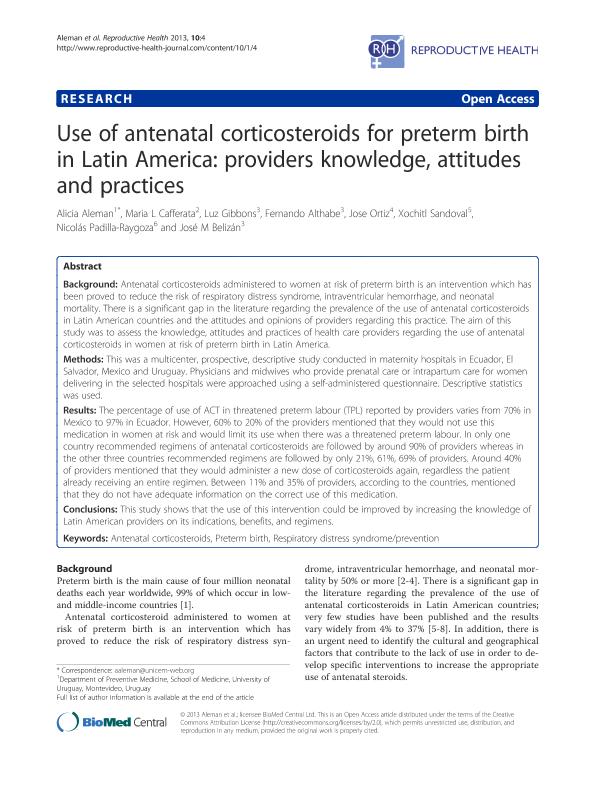Mostrar el registro sencillo del ítem
dc.contributor.author
Aleman, Alicia
dc.contributor.author
Cafferata, Maria L
dc.contributor.author
Gibbons, Luz
dc.contributor.author
Althabe, Fernando

dc.contributor.author
Ortiz, Jose
dc.contributor.author
Sandoval, Xochitl
dc.contributor.author
Padilla Raygoza, Nicolás
dc.contributor.author
Belizan, Jose

dc.date.available
2019-06-18T14:21:26Z
dc.date.issued
2013-01
dc.identifier.citation
Aleman, Alicia; Cafferata, Maria L; Gibbons, Luz; Althabe, Fernando; Ortiz, Jose; et al.; Use of antenatal corticosteroids for preterm birth in Latin America: Providers knowledge, attitudes and practices; BioMed Central; Reproductive Health; 10; 1; 1-2013; 10-14
dc.identifier.issn
0968-8080
dc.identifier.uri
http://hdl.handle.net/11336/78407
dc.description.abstract
Background: Antenatal corticosteroids administered to women at risk of preterm birth is an intervention which has been proved to reduce the risk of respiratory distress syndrome, intraventricular hemorrhage, and neonatal mortality. There is a significant gap in the literature regarding the prevalence of the use of antenatal corticosteroids in Latin American countries and the attitudes and opinions of providers regarding this practice. The aim of this study was to assess the knowledge, attitudes and practices of health care providers regarding the use of antenatal corticosteroids in women at risk of preterm birth in Latin America. Methods: This was a multicenter, prospective, descriptive study conducted in maternity hospitals in Ecuador, El Salvador, Mexico and Uruguay. Physicians and midwives who provide prenatal care or intrapartum care for women delivering in the selected hospitals were approached using a self-administered questionnaire. Descriptive statistics was used. Results: The percentage of use of ACT in threatened preterm labour (TPL) reported by providers varies from 70% in Mexico to 97% in Ecuador. However, 60% to 20% of the providers mentioned that they would not use this medication in women at risk and would limit its use when there was a threatened preterm labour. In only one country recommended regimens of antenatal corticosteroids are followed by around 90% of providers whereas in the other three countries recommended regimens are followed by only 21%, 61%, 69% of providers. Around 40% of providers mentioned that they would administer a new dose of corticosteroids again, regardless the patient already receiving an entire regimen. Between 11% and 35% of providers, according to the countries, mentioned that they do not have adequate information on the correct use of this medication. Conclusions: This study shows that the use of this intervention could be improved by increasing the knowledge of Latin American providers on its indications, benefits, and regimens.
dc.format
application/pdf
dc.language.iso
eng
dc.publisher
BioMed Central
dc.rights
info:eu-repo/semantics/openAccess
dc.rights.uri
https://creativecommons.org/licenses/by-nc-sa/2.5/ar/
dc.subject
Antenatal Corticosteroids
dc.subject
Preterm Birth
dc.subject
Respiratory Distress Syndrome/Prevention
dc.subject.classification
Medicina Critica y de Emergencia

dc.subject.classification
Medicina Clínica

dc.subject.classification
CIENCIAS MÉDICAS Y DE LA SALUD

dc.title
Use of antenatal corticosteroids for preterm birth in Latin America: Providers knowledge, attitudes and practices
dc.type
info:eu-repo/semantics/article
dc.type
info:ar-repo/semantics/artículo
dc.type
info:eu-repo/semantics/publishedVersion
dc.date.updated
2019-06-07T14:30:50Z
dc.identifier.eissn
1742-4755
dc.journal.volume
10
dc.journal.number
1
dc.journal.pagination
10-14
dc.journal.pais
Uruguay

dc.journal.ciudad
Montevideo
dc.description.fil
Fil: Aleman, Alicia. Universidad de la República; Uruguay
dc.description.fil
Fil: Cafferata, Maria L. Unidad de Investigación Clínica y Epidemiológica; Uruguay
dc.description.fil
Fil: Gibbons, Luz. Instituto de Efectividad Clínica y Sanitaria; Argentina
dc.description.fil
Fil: Althabe, Fernando. Consejo Nacional de Investigaciones Científicas y Técnicas; Argentina. Instituto de Efectividad Clínica y Sanitaria; Argentina
dc.description.fil
Fil: Ortiz, Jose. Universidad de Cuenca; Ecuador
dc.description.fil
Fil: Sandoval, Xochitl. Universidad de El Salvador; El Salvador
dc.description.fil
Fil: Padilla Raygoza, Nicolás. Universidad de Guanajuato; México
dc.description.fil
Fil: Belizan, Jose. Consejo Nacional de Investigaciones Científicas y Técnicas; Argentina. Instituto de Efectividad Clínica y Sanitaria; Argentina
dc.journal.title
Reproductive Health

dc.relation.alternativeid
info:eu-repo/semantics/altIdentifier/doi/https://dx.doi.org/10.1186/1742-4755-10-4
dc.relation.alternativeid
info:eu-repo/semantics/altIdentifier/url/https://reproductive-health-journal.biomedcentral.com/articles/10.1186/1742-4755-10-4
dc.relation.alternativeid
info:eu-repo/semantics/altIdentifier/url/https://www.ncbi.nlm.nih.gov/pmc/articles/PMC3598882/
Archivos asociados
